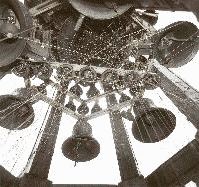|
Sound is everywhere, constantly invading our eardrums and bombarding our systems. We probably only hear 10% of the totalsounds around us. Take a moment to listen—the beep of the microwave, the mouse click, the hum of the fridge, the neighbor kids, the car driving past. And as you build your church, ask yourself about its soundscape, and about the sounds it will be creating. Do they fit your message? Sounds speak. Give your church a voice that people love to hear! Introduction to Russian Bell Acoustics—
|
||||||
|
||||||
|
A typical set of European bells that has come down to us from the Middle Ages usually includes at least a few old familiar bells that have rung for centuries at every important religious event, whose great peals have been recognized by anyone who has spent any time in the vicinity for generations. In fact, it's said that people never forget the sound of their village's bells, no matter how long they are away from home. Bells are memorable and the sound of an old bell is distinctive (though we'll get back to why that's not so true of new bells)— so it's quite natural to ask, "Which notes does it sound?" "Is that a D, or an F?" Yet it's not so easy to tell the sound of a bell as you might think, even with modern electronic analysers! In fact, a bell typically sounds something like this: |
||||||
And if you know a little about musical notation, you'll see that, the low "D" you perceive when the bell is struck (the strike note) isn't even part of this spectrum. Nevertheless, unless you've developed the ability to hear the subtleties, you hear a "D" anyway, because a bell's sound is produced more in the ear than in the air, as it were. So let's talk a little about how a bell makes its sounds.
In all traditions, the age-old art of bell casting, passed down from father to son and from master to apprentice for centuries, allows bell makers to cast bells that are remarkably close to a desired tone. Above are the profiles of typical German, Russian, and French bells. You can see that Russian bells tend to have thicker walls, and thus are heavier than their Western counterparts. But that's not the only difference between European and Russian bells. Western bells nowadays are usually tuned after casting to a precise tone by grinding down their surfaces or by trimming them on a lathe. In the Russian tradition, however, this tuning would be impermissible, as it would ruin the bell's "personal" distinctiveness. Moreover, because Russians consider bells to be rhythm rather than melody instruments, precise melodic tuning is not so important (or even desirable) as it would be in bells made for a carillon, for example.
This is the main difference between Russian and European bells. European bells are precise, machine-tuned instruments, scientifically designed to fit into large carillons, which really are grand metallic pianos. Russian bells are cast for a tone, but not refined after they come forth from the mould. We could say that the sound of a Russian bell is to that of a European bell, as the taste of granola is to that of white bread. Tuning large ensembles of bells to particular notes permits the construction of enormous campaniles such as that of the Rockefeller Carillon in New York or the carillon at the University of California at Berkeley. This tradition really began on a large scale only in our century, thanks to the efforts of Dutch and Belgian firms. Using computer technology, a bell's profile can now be designed so that its fundamental tone is maximized, and its overtones and humming are muffled. On every bell certain zones emit particular sounds in spectrum when the bell is struck. These zones can be sanded down on the inside wall to correct or alter the resonance of the to alter the bell's fundamental tone. But this is not done for Russian bells. Bell towers usually contain 30 to 40, or even more, bells arranged in several chromatic octaves which allows even the most complex melodies to be played as if they were a piano scores. Today, clock towers are being mechanized to automatically chime, as they are being equipped more and more often with electronic controls. The sound of a bell used in one of these installations needs to be as disciplined and correct as a soldier in formation. No note should "jump out" of the spectrum and result in disharmony. But because Russian bells are rhythm instruments (drums), a certain amount of disharmony is tolerable and, indeed, even interesting.
That's the main difference, right there— in the fact that Russian bells are played like drums, and European bells like pianos. A definite musical phrase flows from the peal of several Russian bells when they are rung in a particular way: the slowly tolling boom of the big bell is sprinkled by a quick clangor of the mid-sized ones, all according to a pattern, which repeats itself even as it evolves. But the line is not a melody line, except perhaps in a very rudimentary way. For the same reasons, smaller tintinnabula are not in much demand in Europe, and bell companies there hardly ever cast them. Yet you'll find small (<10 kg) bells playing together with large bells (>30 T) bells in Russia, because the main purpose is not melody. In fact the sound of European bells is quite powerful since the bell itself produces the sound as it strikes a freely swinging clapper with full the momentum of its entire weight-- as opposed to the Russian method, where the sound is produced by the clapper as it is pulled against the stationary bell. This manner of striking not only allows the smaller bells to be heard more readily, but also determines the unique technique of the Russian zvon.
Thus we stress: Russian bells are rhythm instruments. Zvonars like the one in the picture to the left do not so much play melodies, as rhythmic patterns, often syncopated and not altogether unlike jazz percussion or African 'talking drum' ensembles. But as to the tuning of bells, very characteristic of the Orthodox approach is the fact that it's the distinctive, 'personal' voice that we value. A bottle-shaped bell has even been invented which is tuned in a major key whose main overtone sounds with the base tone in major, not minor, thirds. Another, conical bell has been invented, whose seven perfectly tuned partial harmonics mimic those of the human voice. This has been something of a holy grail for Western bell makers and hence the bell has been called a "perfect bell". Russian bell makers are concerned with tuning, but this quest for a "perfect" bell is not of special interest to them. There's more to the difference between machine tuning and natural tuning than just granola and wonderbread. We don't use Western pictures and music in our churches– even the very best of Western art– because neither of its characteristic techniques of abstraction or substitution can actualize the personal event of communion that Christianity is. And the same may be said of bells. Sanctified from very day of their casting to announce traditional liturgical harmonies, each bell with its ownmost unique, distinctive voice, the whole ensemble played by hand in a personal manner– Russian bells express the same Logos and are oriented to the same Dawn as everything else in our sanctuaries, whose voices they in fact are. Elsewhere on this site we have some further notes on this theology; and also some technical articles, mostly from Western sources, relating to the tuning and acoustics of bells, both Russian and non-Russian. You can also find actual samples of Russian bell music by clicking here, and some of the rules for how to do it here. |
||||||
|
|






